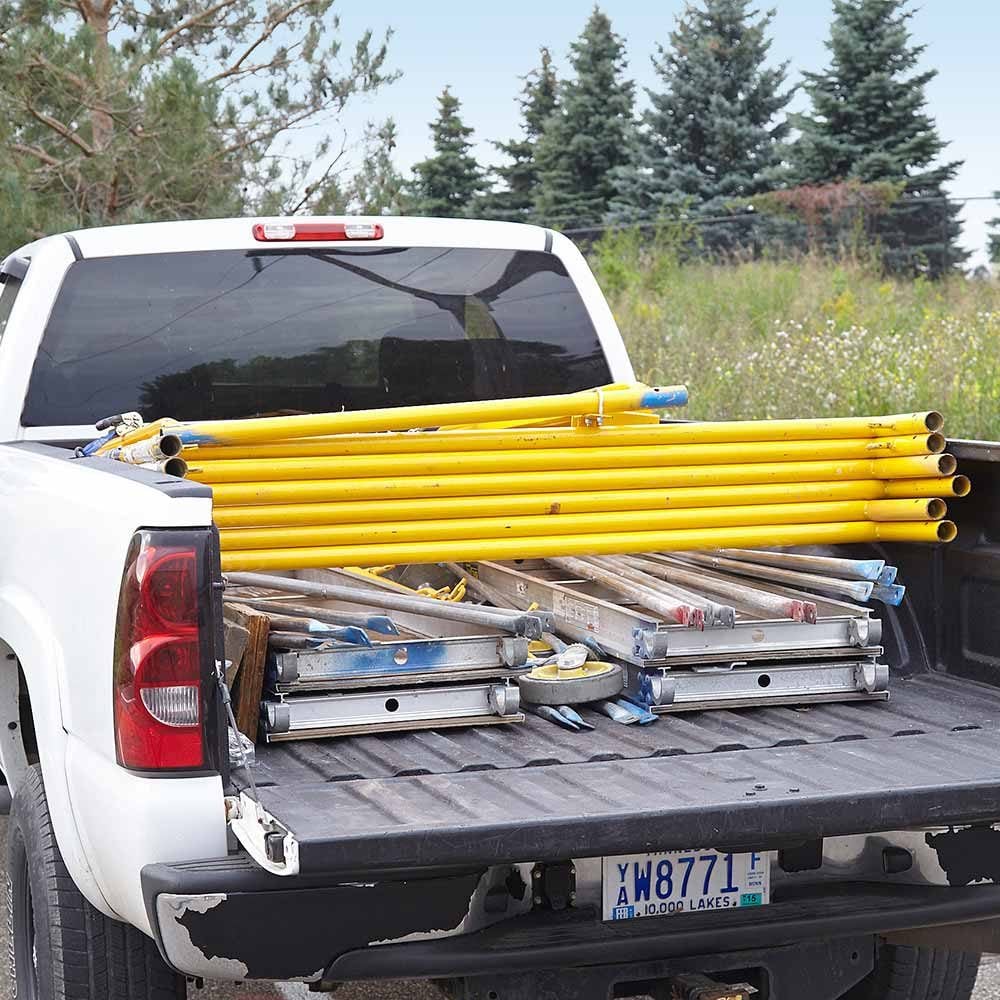Whether you are replacing light bulbs in a sky warehouse or replacing the windows in a two-story home, here is how to use scaffolds to get things done off the ground safely.
Haul Scaffolding Safely

Place the planks, the support plates and the bases between the wheel bases on the bottom and put the frames on top. Avoid putting scaffolding frames on the side of the bed. It is best to have everything as low as possible, so parts don’t get blown or bounced out. Frames that extend out from the side of the bed can be dangerous if someone is walking next to a truck.
Plank the Whole Bay
If possible, cover the entire width of the scaffold with planks. This creates a larger working area and reduces the risk of falling. If this is not possible, especially if you are working in the middle of a ladder frame, install another plank higher up to create a protective barrier. If you are working on wheels, install a diagonal “gooser” brace. This will keep the scaffolding square and stable.
How to Set Up Scaffolding Safely
Install the wheels or base jacks first, so you don’t have to lift the whole scaffold to push them in. Install both cross braces on the same frame. It should stand upright with the support of the cross braces (above). Put the other frame in place and attach the cross braces to it (below). Slide the scaffold about 14 inches from the wall before installing the planks.
Install a Guardrail
Installing guardrails is the best way to avoid accidentally stepping off the edge of the platform. However, safety guards are not necessary when working on any scaffolding. If you fall while wearing a safety harness, you could drag the entire platform with you, endangering everyone working on it.
Maintain a Three-Point Grip
When climbing the scaffolding, always keep a three-point grip. This means that one hand and two feet, or one foot and two hands, must contact the scaffold. Maintain your body as close to the frame as possible. Moving too far out can cause the entire works to fall. And never climb on the cross braces; they are not designed to support the weight.
Setting Up Scaffolding on Uneven Ground
Scaffolding frames are intended for use with either wheels or base plates. If you leave them in place, the frame tubes may be damaged and structurally weakened. Place a 2×10 wooden block under each leg, even if you are using a base plate. This will help prevent sinking into soft soil or hot asphalt.
Placing scaffolding on the blocks is unnecessary when working on concrete but it is still a good idea. An uneven floor or a slightly bulging sub-base can create a small mating surface. The slight flexibility of the wood ensures excellent, even weight distribution. When working on uneven surfaces, level and plumb the scaffolding with an adjustable base jack. Never place scaffolding on top of masonry or wood piles.
Working on Scaffolding

Safety first:
- Keep planks clean to reduce the risk of someone tripping or knocking things over to unsuspecting people below.
- Keep your tools and supplies in toolboxes, buckets and caddies whenever possible.
- Install a 2×4 toe board to avoid items being dropped.
- Secure it with wire at the corners.
It is tempting to hang tools from rails, but don’t do it. Adding weight to the railings increases the likelihood that they could fall if someone leans against them. Protective harnesses for ground workers are always a good idea.
Access the Platform With a Ladder
Use a ladder to access the scaffold safely and easily, especially when working with wooden boards hanging over the ends. Run the ladder at least 3 feet along the surface of the planks. Support the ladder against the wall rather than the scaffold itself; otherwise, you may tip it over when climbing up.
Build a Handy Workbench
One way to tidy up your workspace is to set up a workbench by fitting planks higher than those you walk on. A workbench also adds a level of safety because you will be less likely to trip on supplies and tools.
Stay Clear of Power Lines
You don’t have to touch a power line to get electrocuted. Electricity can arc from the line to conductive materials (like scaffolds). Keep a minimum distance of 10 feet from all power lines.
For all your scaffolding needs in Melbourne, contact Stilcon Scaffolding. Having the help of construction experts is crucial when it comes to the structures of any building. Give them a call for a free quote.